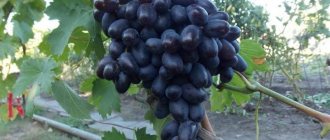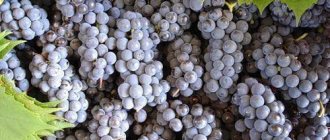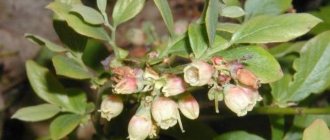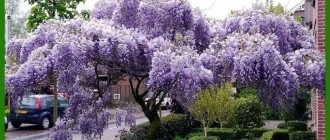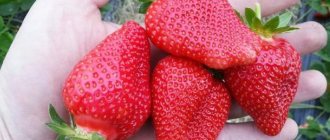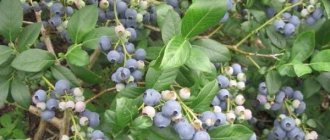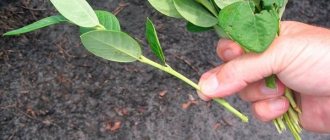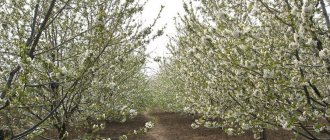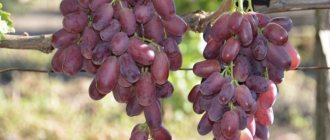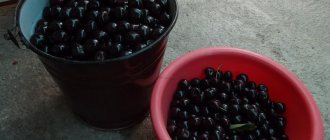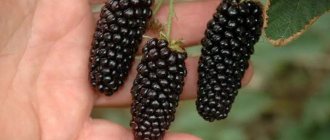Description and photo of Daria grape variety
This species was obtained by crossing the species qualities of the hybrid Kesha and the universal variety Druzhba. This selection work was carried out by V. N. Krainov. The main purpose of crossing these species was to develop a hybrid resistant to major crop diseases such as oidium and mildew. And the final result of the selection fully met expectations.
Daria grapes are characterized by vigorous bushes up to 2.5 m. The vine ripens well throughout the season. The leaves of the hybrid are five-lobed with slots and characteristic teeth along the edge. They have a rich green tint.
According to the description, Daria grapes (photo above) have bisexual flowers, which guarantees stable fruit set regardless of weather conditions. Fruiting of the bush occurs 2-3 years after planting the seedling in a permanent place. Since Daria is an early ripening species, this species is suitable for cultivation not only in the southern, but also in the central and northern regions, with obligatory shelter for the winter.
The hybrid is distinguished by its heart-shaped clusters. By the time they are technically ripe, the berries acquire an amber hue. The fruits are oval-shaped, medium in size. The peel is dense and edible. The pulp is juicy with 2-3 seeds. The taste of the fruit is unobtrusively nutmeg.
Bunches of Daria grapes have a dense or medium-loose structure. Their weight is 700-900 g. The hybrid is resistant to peas and is characterized by high commercial qualities.
Who is Dasha Daria's relative or friend?
Most likely a friend. Since the hybrid was created through the efforts of the Potapenko VNIIViV together with Zaporozhye breeders. Therefore, the table variety “Gift to Zaporozhye” was taken as the basis for the parent pair, which has the following qualities as a “dowry”:
- high productivity;
- average ripening period for large (up to 1 kg) brushes;
- fixed immunity to oidium and mildew;
- simple taste of green berries (20% sugar content);
- frost resistance within - 24°C.
The mother plant was the white table variety “Arcadia” (Ukrainian selection) - vigorous and large-fruited, but with a lower resistance to rot, and mandatory protection of the frost-vulnerable bush in the cold season. The variety's maternal gift is recognized as: golden-colored berries with a muscat taste, collected in powerful clusters weighing up to 2 kg.
“Dasha” has a specific creator - Vitaly Vladimirovich Zagorulko, a Zaporozhye amateur breeder who laid the foundation for his collection back in the 90s of the last century, collecting more than 30 new hybrid forms of grapes.
Interesting: Winegrowers have something to strive for: the record weight of a bunch was registered at the end of the last century in Chile - 9,500g.
Specifications
According to the description, the Daria grape variety (photo above) has an early ripening period, so harvesting can be done in the first half of August. Later ripening of the bunches indicates overloading of the bush.
Thanks to the dense skin of the fruit, the hybrid has a long shelf life of 1 month. Grapes of this type are distinguished by their versatility, so they can be used for fresh consumption and for processing.
According to the description, Daria grapes have the following qualities:
- sugar accumulation - 21-24%;
- acidity - 5 g/l;
- tasting taste score - 8-9 points;
- frost resistance - -23 degrees;
- berry weight - 12-14 g;
- the average weight of a bunch is 700-900 g;
- ripening period - 105-115 days;
- the number of fruitful shoots is 65-85%;
- resistance to diseases - at the level of 3 points.
When growing this type of crop, it is recommended to use medium pruning of the vine with 6-8 buds. The total load on the bush should be within 30-35 buds, since ignoring this rule leads to a slowdown in fruit ripening and a decrease in the marketable yield of berries.
Agrobiological properties
The growth vigor of grape bushes is high. The leaves are large, round, five-lobed, very beautifully indented. Both the upper and lower notches are deep, often closed with an ovoid opening, less often open in the shape of a lyre with a rounded bottom, some also have parallel sides. The surface of the leaf is smooth, dark green, on which lighter veins are clearly defined. The profile of the leaf blade is flat or slightly wavy. The petiole notch takes on a variety of shapes, from closed with a rounded opening to open, wide-vaulted. The petioles are long, colored reddish in varying degrees of intensity. The denticles along the perimeter of the leaf are of considerable size, usually triangular with a wide base, straight or slightly curved edges and pointed apices. The flowers are bisexual, the pollen has good fertility, due to which pollination occurs well, the berries set well, forming a perfectly executed bunch without signs of peas. Shedding of buds and ovaries was also not noticed. During the growing season, the annual growth has time to mature sufficiently. In autumn, the vine becomes yellowish-brown at the internodes and darker in color at the nodes.
Maturing brushes are very large in size, their weight often reaches one and a half kilograms, and the average weight is about 600 - 800 grams. The shape of the bunches is conical or wide-conical, the structure is moderately dense. There is no damage to the berries against each other or their deformation. The uniformity of their caliber gives the brushes a special elegance and attractive appearance. The combs are long, herbaceous, but quite strong, light green with longitudinal stripes of anthocyanin tones. The grapes are massive, ovoid, with an average weight of 12 - 14 grams, individual ones - up to 20 g. The outside of the berries are colored light milky or yellowish with a greenish tint, the skin is covered with small brown dots and a thin layer of whitish waxy coating. The fruit pulp is dense, juicy and fleshy, with a stunningly harmonious taste with a long, persistent aftertaste due to the bright aroma of citron-type nutmeg. The juice is colorless, it is distinguished by high sugar content - about 19 - 20 g/100 ml. There is no exact information about the content of titratable acids in the juice, however, judging by the harmonious taste of the berries, this parameter is within standard limits. The skin is medium in density and thickness and chews well when eaten. The seeds are present, usually two per berry, but do not have a significant negative effect.
The grown crop is mainly used for fresh consumption. The excellent appearance, taste and aroma of grapes leave no one indifferent. Farmers who cultivate the hybrid form for commercial purposes note its unconditional “marketability”. The only drawback when selling is the greenish color of the grapes, however, having tried Daria and appreciating its delightful gastronomic characteristics, buyers willingly purchase it, and the bunches do not linger on the shelves. A big advantage is that our heroine ripens relatively early and is sold during a period of high grape prices, providing its owners with sufficient profitability of cultivation. Unfortunately, the crop is not intended for long-distance transportation due to its average transportability, but it gets from the field to local markets without losing its excellent presentation at all. It is also not suitable for long-term storage, however, the use of refrigeration chambers or basements with low temperatures allows you to avoid massive spoilage of berries within a month. If this is not possible, then the excess grapes can be used in home canning. It will make juices, compotes, jams and marinades that are excellent in all respects, fragrant with the incomparable aroma of nutmeg.
From the moment the eyes awaken in the spring, about 105 - 115 days pass until the time when the clusters reach their removable ripeness, soften, accumulate sufficient sugar and reduce acidity. With such a growing season, Daria is one of the very early varieties that require a very modest amount of active temperatures, in the range of 2200 - 2400 °C, for the development and ripening of fruits. This fact opens up prospects for winegrowers to cultivate the form not only in the abundantly warm south, but also in the middle zone of the country, where not every grape variety has time to ripen.
Related article: Krasa Dona grape variety
Certain restrictions on the promotion of the hybrid north of traditional viticultural zones are imposed by the not very high frost resistance of the vine, which does not exceed −22…−23 °C. However, the formation of plants according to squat, standard-less patterns and careful insulation of the bushes for the winter eliminates this problem in the vast majority of cases. Cover cultivation is also practiced by many owners of the variety who cultivate “sunny berry” in the southern regions. In this way, they are reinsured against freezing of plants in the event of abnormally cold winters for these places.
Daria's productivity reaches very high values due to her good fertility and large brush size. From each adult bush you can consistently get up to 20 kilograms of high-quality harvest, and the plants themselves strive to lay much more of it, thereby creating the preconditions for their own overload. If you do not limit this tendency by strictly regulating the number of shoots and bunches, you may encounter all the “delights” of an exorbitant load - a deterioration in the growth energy of the vine and its late ripening, prolongation of the growing season, shredding and a decrease in the taste of the fruit. To prevent this, during spring pruning, no more than 30 - 40 eyes are left on the bushes, with a length of fruit shoots of 6 - 8 buds. Be sure to remove fruitless and weak shoots, and remove excess inflorescences from fruitful ones.
After ripening, the clusters can hang on the vine for a long time without cracking or raisining, even under unfavorable weather conditions. Gray rot, as a rule, does not damage berries, and the hybrid has average resistance to other fungal diseases. A few preventative treatments with systemic fungicides will be sufficient to control common pathogens.
Landing Features
The hybrid is not picky about soil composition, but does not tolerate stagnation of moisture and drying out of the root. Daria gives maximum results when grown on sandy and loamy soils.
The place for planting the seedling should be chosen as open and sunny, so the ideal option is the south, west and south-west side of the site. When planting, you should maintain a distance between seedlings of 1-1.5 m in a row and 5-6 m to the nearest trees.
Planting grapes can be done in spring or autumn in this sequence.
- Dig a hole 50 cm deep and 40 cm wide.
- Place broken brick or crushed stone 10 cm high at the bottom.
- Pour a layer of earth on top and make a small mound in the center.
- Dip the roots of the seedling into a mash consisting of 1 part clay and 2 parts humus.
- Place the plant in the center on a hill, straighten the roots.
- The root collar should be positioned 5 cm above the soil surface.
- A wooden support must be placed next to the seedling.
- Cover the hole with soil, shaking the cutting slightly to fill all the voids.
- Compact the soil at the base.
- Water the plant by pouring 20-30 liters of water at the root.
- Trim the shoots into 2 buds.
- The next day after planting, loosen the soil around the seedling and mulch with humus or peat.
The life potential of a grape bush is 20 years, so you must immediately place the plant correctly on your site. The stability of the harvest and the quality of the bunches directly depend on this.
Further care
In the future, it is recommended to follow simple care recommendations.
As the seedling grows, it is necessary to use a support and then wooden trellises, which will reduce the likelihood of damage to the vine by redistributing the load of the bush.
In the absence of seasonal precipitation, it is recommended to regularly water the seedling. During the period of filling the berries (2 weeks before harvest), irrigation should be stopped to prevent cracking of the fruit. If necessary, it is better to use drip irrigation between rows.
Throughout the season, it is recommended to carry out 3 feedings:
- during the active growing season - nitrogen fertilizers;
- before flowering - phosphorus-potassium and organic fertilizers;
- during the period of fruit formation - phosphorus-potassium fertilizers.
A few days before flowering, experts recommend pinching young shoots, which promotes the formation of large clusters. Ripe fruits must be left on the plant for several days, which will enrich their taste.
In the central and northern regions, grapes must be covered for the winter. To do this, you need to remove the vine and lay it on the soil. Insulate the root by pouring an additional layer of soil 10 cm thick and compact it. For this, the soil should be taken at a distance of at least 1.5-2 m from the bush, so as not to inadvertently expose the roots.
To cover the shoots, you should use agrofibre, spruce branches or burlap, that is, only those materials that can breathe, otherwise the shoots may dry out.
It is necessary to cover plants when the air temperature is consistently below 0, as these shelters attract field mice. Rodents eat the bark at the base of the bush, which subsequently leads to the death of the plant.
Diseases and pests
Daria grapes are highly resistant to gray rot, highly resistant to mildew and moderately resistant to oidium. Therefore, to obtain a good harvest, it is enough to carry out no more than 2-3 treatments with fungicides throughout the entire season.
According to reviews from gardeners, this hybrid is not damaged by wasps. In addition, Daria grapes are highly immune to common crop pests, such as spider mites, leaf rollers, and phylloxera.
Advantages of the variety
This hybrid has a number of advantages, among which are the following:
- early ripening, which allows you to grow Daria grapes in regions with harsh climates;
- stable ovary and fruiting;
- pleasant nutmeg taste;
- undemanding to care and soil composition;
- long shelf life of fruits (1 month);
- good transportability;
- resistance to diseases and pests;
- high vital potential of the bush;
- large size of bunches;
- propagates well by cuttings;
- fast growth, good ripening of the vine;
- high level of frost resistance.
Who is Dashunya?
“Dashunya” appeared on a 30-acre plot of land near Kiev.
The creator of this interspecific hybrid was a breeder from the people who improved the plants in his garden, first of all, for his family: for taste, winter hardiness, and resistance to fungal diseases.
It was now, when his seedlings had dispersed far beyond the Volga, that they began to say: “The collection of Nikolai Vishnevetsky. Breeding sample of Vishnevetsky.”
Fans began to look on the Internet for a way to contact the author in order to get his hybrid. Nikolai Pavlovich responds to many with regret that it is now impossible to send cuttings to Russia, unless sent by opportunity or self-pickup - the international situation.
Who did Nikolai Pavlovich choose as “Dashune’s” parents:
- Kesha 1 - this is a family connection with Daria!
- Radiant raisins. Crossing these two varieties has already once produced at VNIIViV Novocherkassk the “Kesha Radiant” variety with a reduced number of seeds in the berry.
- Rizamat (Uzbek selection) is a table and raisin grape with a very high fructose content, early ripening and impressive yield - up to 250 c/ha. True, the parent was inferior to the other two in resistance to mildew, but had a beautiful rich pink color of the bunch.
You can already imagine all the advantages of the newly-minted “Dashuni”:
- beautiful decorative color of brushes;
- fleshy fruits with nutmeg taste;
- desirable resistance to fungal infections.
Interesting: Using the examples of the described varieties, you can see how far they have advanced to the north of Russia. Now the border of their range runs: Kamennogorsk - Vologda - Yekaterinburg.
Video about the Dashunya grape variety:
https://youtu.be/HKfAtCeH0BQ
Reviews
According to gardeners, the hybrid form of Daria grapes managed to absorb the best qualities of its ancestors. As a result, this species is not only distinguished by the beautiful appearance and taste of the bunches, but also has increased resistance to common diseases and pests. These qualities of the crop make it possible to achieve good and stable yields with minimal plant care.
But you can also find unflattering reviews about Daria grapes. In most cases, they relate to the wateriness of the berries during a rainy summer. But, according to the gardeners themselves, this problem can be solved by leaving the ripened bunches on the bush for 7-10 days.
From everything it becomes clear that Daria grapes are a worthy type of crop that is worth paying attention to.
A little about selection
Violet “blue fog”: photo and description of the Moreva variety, rules of cultivation and care
Creating a new variety as a predictable stable trait is a difficult and time-consuming task.
After all, in order to determine the parameters of a new variety, a whole team of specialists has been studying and analyzing the leading characteristics of hybrid forms for 15 years, or even more, and selecting the best specimens for cloning.
Then comes the time for field testing in different climatic conditions.
The prototype ends up in the gardens of amateur gardeners, who also have a hand in improving the plant by selecting clones, and sometimes improve its gene pool through their own efforts.
Thus, by the time a new variety is registered in the State Register, several variants of hybrid forms may arise that have lost their resemblance to their common ancestors.
A plant acquires variety status only after being included in the State Register - the main document of innovative additions to winegrowers, and can exist in a hybrid form under different names for decades.
This happened with “Daria”, who received life in the selection laboratory of V.N. Krainov in Kuban. While it has not yet received variety status, it is being tested, and is, in the generally accepted understanding, a hybrid form.
Interesting: In the process of hybridization, any bisexual variety can be chosen as the paternal form, and the maternal one (after castration of the stamens) will be pollinated to produce hybrid seeds.
Among the hybrids, Jubilee of the Kherson Summer Resident, Korolek, Valery Voevoda and Gordey are widely popular.
